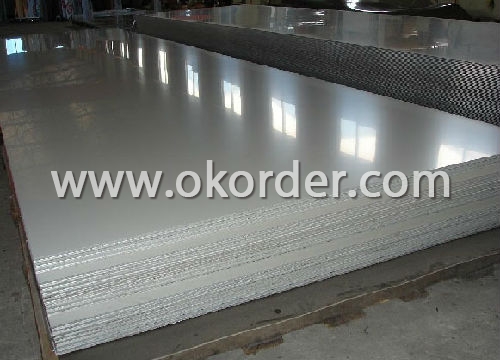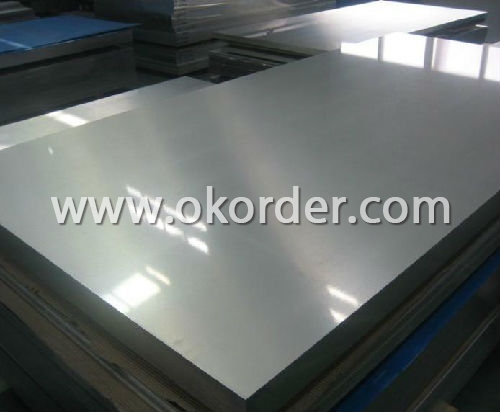AISI 201 Stainless Steel Plate
- Loading Port:
- China Main Port
- Payment Terms:
- TT or LC
- Min Order Qty:
- 1 Ton m.t.
- Supply Capability:
- 2000 Tons Per Month m.t./month
OKorder Service Pledge
OKorder Financial Service
You Might Also Like
AISI 201 Stainless Steel Sheet
1. Chemical composition of AISI 201 Stainless Steel Sheet
C | Si | Mn | P | S | Ni | Cr |
max0.15 | max1.00 | 5.50-7.50 | max0.06 | max0.03 | max1.00 | 16.00-18.00 |
2. Mechanical properties of AISI 201 Stainless Steel Sheet
Yield Strength | Tensile | Elongation | Hardness (HV) | Hardness (HRB) |
245 | 640 | 40 | 253 | 100 |
3. Standard of AISI 201 Stainless Steel Sheet: AISI, ASTM, GB, EN, DIN, JIS
4. Surface of AISI 201 Stainless Steel Sheet: 2B, NO.1, BA, NO.4, Hairline, SB, Mirror finish, Anti-skid, Cherkered etc.
5. Size of AISI 201 Stainless Steel Sheet:
Thickness: 0.3-3mm (cold rolled), 3-40mm (hot rolled)
Width: 1000mm or 1219mm or 1240mm for cold rolled, 1500mm for hot rolled.
Length: As customers' request.
6. MOQof AISI 201 Stainless Steel Sheet: 1 Ton
7. Payment terms of AISI 201 Stainless Steel Sheet:T/T or L/C
8. Packing of AISI 201 Stainless Steel Sheet: Seaworthy package with wooden or Iron pallets with the paper and the steel strip,
or as customers' request.
9. Delivery time of AISI 201 Stainless Steel Sheet: Usually about 7 days after we confirming the order, or according to your quantity.
If you have any question or demand, pls feel free to contact me.


- Q:Can stainless steel strips be used in harsh weather conditions?
- Stainless steel strips are capable of withstanding even the harshest weather conditions. Renowned for its outstanding resistance to corrosion, stainless steel is highly impervious to rust and other forms of deterioration caused by exposure to moisture, humidity, and extreme temperatures. Consequently, stainless steel strips prove to be a dependable and long-lasting choice for various applications that experience adverse weather, such as outdoor structures, building facades, roofing, and marine environments. The corrosion resistance of stainless steel can be attributed to the presence of chromium within its composition, which creates a protective layer on the metal's surface, preventing it from reacting with the surrounding environment. Moreover, stainless steel also possesses resistance to UV radiation and can endure strong winds, making it a suitable option for regions prone to storms and hurricanes. In conclusion, stainless steel strips offer an outstanding solution for applications that necessitate strength, durability, and the ability to withstand harsh weather conditions.
- Q:What are the factors affecting the electrical conductivity of 111 stainless steel strips?
- The factors affecting the electrical conductivity of 111 stainless steel strips include the alloy composition, impurities or contaminants present, temperature, and mechanical processing techniques such as cold working.
- Q:Can 111 stainless steel strips be used in the pulp and paper industry?
- In the pulp and paper industry, the utilization of 111 stainless steel strips is feasible. This industry extensively employs stainless steel due to its ability to resist corrosion, its robustness, and its durability. It serves various purposes, including the production of paper machines, screens, and other equipment that are exposed to corrosive chemicals and liquids utilized in the pulp and paper manufacturing process. The 111 grade stainless steel, known as AISI 111 or S11100, is a low carbon variant that demonstrates desirable weldability and resistance to intergranular corrosion. Hence, it presents itself as a suitable material choice for specific requirements in the pulp and paper industry. Nevertheless, it is vital to assess the application and conditions meticulously to ensure that the stainless steel strips satisfy the necessary mechanical and chemical properties for optimal performance.
- Q:How do stainless steel strips resist erosion?
- Due to its unique composition and properties, stainless steel strips possess the capacity to withstand erosion. Primarily, stainless steel is an alloy containing a high chromium content, resulting in a protective layer of chromium oxide forming on its surface. This layer acts as a barrier, preventing oxygen and moisture from reaching the underlying metal, thus safeguarding it against corrosion and erosion. Furthermore, stainless steel strips exhibit exceptional resistance to acids, alkalis, and various chemicals, making them suitable for usage in harsh environments. The presence of other alloying elements like nickel and molybdenum further enhances the corrosion resistance of stainless steel. Moreover, the structure of stainless steel, especially austenitic stainless steel, provides excellent strength and toughness, enhancing its resistance against mechanical erosion. The combination of corrosion resistance and mechanical properties enables stainless steel strips to endure erosive forces and exhibit high durability. Additionally, various surface finishes such as passivation or electro-polishing can be applied to stainless steel strips, further bolstering their resistance to erosion. These treatments eliminate impurities and contaminants from the surface, resulting in a smoother and more corrosion-resistant finish. In conclusion, the ability of stainless steel strips to resist erosion stems from their corrosion-resistant composition, surface treatments, and outstanding mechanical properties. These attributes render stainless steel an ideal material for numerous applications where erosion resistance is critical, such as the production of automotive components, kitchen appliances, and chemical processing equipment.
- Q:What is the thermal expansion coefficient of stainless steel strips?
- The thermal expansion coefficient of stainless steel strips can vary depending on the specific grade of stainless steel being used. However, in general, stainless steel has a relatively low coefficient of thermal expansion compared to other materials. The coefficient of thermal expansion is a measure of how much a material expands or contracts when exposed to changes in temperature. Stainless steel typically has a coefficient of thermal expansion ranging from about 10 to 17 µm/m°C (micrometers per meter per degree Celsius). This means that for every degree Celsius increase in temperature, a stainless steel strip will expand by approximately 10 to 17 micrometers per meter in length. It is important to note that the exact coefficient of thermal expansion may vary depending on the specific alloy composition and heat treatment of the stainless steel. Therefore, it is recommended to consult the manufacturer's specifications or conduct specific testing to determine the precise thermal expansion coefficient of a particular stainless steel strip.
- Q:Can stainless steel strips be used in the production of kitchen utensils?
- Certainly, the utilization of stainless steel strips in the manufacturing of kitchen utensils is indeed possible. Stainless steel has become widely preferred for kitchen utensils owing to its numerous advantageous qualities. Its resistance to corrosion, heat, and ability to maintain hygiene make it an ideal material for food preparation and cooking purposes. The malleability of stainless steel strips allows for easy shaping and crafting of a diverse range of utensil designs such as spoons, forks, knives, spatulas, tongs, and an array of others. Furthermore, the durability and longevity of stainless steel utensils guarantee their ability to endure the demands of everyday kitchen usage.
- Q:Can stainless steel strips be painted or coated?
- Yes, stainless steel strips can be painted or coated. However, it is important to properly prepare the surface before applying any paint or coating to ensure adhesion and durability. This typically involves cleaning the stainless steel thoroughly and using a primer or etching solution to promote better bonding. After the surface is prepared, various types of paints or coatings can be applied, such as epoxy, acrylic, or enamel. It is important to select a paint or coating that is specifically formulated for use on stainless steel to ensure the best results. Additionally, proper drying and curing times should be followed according to the manufacturer's instructions to achieve the desired finish and durability.
- Q:What is the maximum temperature that stainless steel strips can withstand?
- The specific grade of stainless steel determines the maximum temperature that stainless steel strips can tolerate. Stainless steel is generally recognized for its exceptional heat resistance. The commonly employed stainless steel grades, such as 304 and 316, can usually endure temperatures of approximately 1500°F (815°C) without undergoing significant oxidation. Nevertheless, there are specialized stainless steel grades designed for high temperature applications, such as 310 and 321, which can withstand even higher temperatures, up to 2100°F (1150°C). To ascertain the maximum temperature resistance of a particular stainless steel strip, it is crucial to consult the manufacturer or refer to the technical specifications.
- Q:What are the surface finishes available for 111 stainless steel strips?
- Some common surface finishes available for 111 stainless steel strips include mill finish, brushed finish, polished finish, and embossed finish.
- Q:What is the formability of stainless steel strips?
- The formability of stainless steel strips is generally considered to be good. Stainless steel is known for its excellent mechanical properties, including its ability to be shaped and formed into various complex geometries. This is due to its high ductility and low work hardening rate. Stainless steel strips can be easily bent, stretched, and formed into different shapes without cracking or breaking. However, the formability of stainless steel strips can vary depending on the specific grade and thickness of the material, as well as the processing conditions and techniques used. It is important to consider factors such as the composition, grain structure, and surface condition of the stainless steel strips when evaluating their formability. Overall, stainless steel strips are often preferred in applications where good formability is required, such as in the automotive, construction, and manufacturing industries.
1. Manufacturer Overview |
|
|---|---|
| Location | Shandong,China |
| Year Established | 2005 |
| Annual Output Value | Above US$5.3 Million |
| Main Markets | Europe, China |
| Company Certifications | ISO9001:2000 |
2. Manufacturer Certificates |
|
|---|---|
| a) Certification Name | |
| Range | |
| Reference | |
| Validity Period | |
3. Manufacturer Capability |
|
|---|---|
| a)Trade Capacity | |
| Nearest Port | Tian Jin |
| Export Percentage | 30% |
| No.of Employees in Trade Department | 40 People |
| Language Spoken: | English;Chinese |
| b)Factory Information | |
| Factory Size: | Above 50,000 square meters |
| No. of Production Lines | Above 8 |
| Contract Manufacturing | OEM Service Offered;Design Service Offered |
| Product Price Range | Average |
Send your message to us
AISI 201 Stainless Steel Plate
- Loading Port:
- China Main Port
- Payment Terms:
- TT or LC
- Min Order Qty:
- 1 Ton m.t.
- Supply Capability:
- 2000 Tons Per Month m.t./month
OKorder Service Pledge
OKorder Financial Service
Similar products
New products
Hot products
Hot Searches
Related keywords





























